Dresden marked my return to Germany after two weeks in Austria and the Czech Republic. I particularly wanted to photograph the Opera House – generally known as the Semperoper, after its architect Gottfried Semper – and I'd so far carried my tripod for 3,000km of rail travel to enable me to do so at night: arguably its best view thanks to the good floodlighting. The other important building on my list was the Frauenkirche, the iconic Lutheran church which collapsed the day after the Allied bombing of Dresden in February 1945, and which was finally rebuilt between 1993 and 2005.
In 1817, 24 years before the opening of Semper's opera house, the composer Carl Maria von Weber (1776-1826) was appointed court Kapellmeister and director of the Dresden Opera. Heinrich Schütz – one of JS Bach's great predecessors – had been Kapellmeister 200 years earlier, from 1615 to 1657, but there seems nothing here to commemorate him today apart from occasional performances of his choral works by the choir of the Kreuzkirche. Richard Wagner was conductor of the Opera from 1843 to 1849 following a very successful production here of Der Fliegender Holländer [The Flying Dutchman]... / more |
Semperoper
The opera house has had a chequered history. It was built by Gottfried Semper in 1841, destroyed by fire in 1869, and rebuilt in 1878 by Semper's son Manfred using his father's design. It suffered badly in WWII, eventually reopening in February 1985, 40 years after its destruction, with a performance of Weber's opera Der Freischütz. In 2002 it was badly damaged yet again when the nearby river Elbe flooded. One evening I went there with my camera and tripod, and spent 45 minutes messing about with multiple long exposures...
• Click for photos and more |
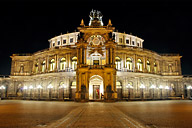 |
Frauenkirche
The reconstruction of the Frauenkirche, Dresden's best-known landmark, is remarkable. The church was designed in the 1720s by George Bähr and completed in 1743, just after the Semperoper. Its structure famously survived the firebombing towards the end of WWII, but collapsed dramatically the following day. It lay as a pile of rubble for 45 years during the Communist era. Reconstruction work began in 1993 and was completed in 2005. The light interior is a superb mix of ornate Baroque and beautiful pastel plasterwork, very pinky and delicate...
• Click for photos and more |
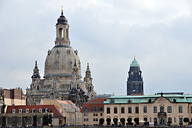 |
Kreuzkirche
I moved on to the Kreuzkirche, which also suffered in WWII as well as in several other disasters. It was known as the Nicolaikirche as early as 1215, and was reconsecrated as the Church of the Holy Cross in 1388. It's been destroyed by fire or military action four or five times over the years, each time being rebuilt. I found it calm and welcoming. Panels hanging around the nave quietly promoted a reconciliation project based in Oswiecim, Poland, which has so far arranged over 2,500 group visits to Auschwitz...
• Click for photos and more |
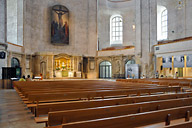 |
Zwinger
The Zwinger was built between 1710 and 1728 by the noted architect Matthaeus Daniel Pöppelmann, in co-operation with the sculptor Balthasar Permoser, as a great open stadium for festivals and tournaments. It consists of six pavilions connected by large galleries. As originally built it was open on one side, as the money had run out for further construction, but the space was eventually filled in 1855 when Semper built the gallery that lines one side of the square in front of his opera house...
• Click for photos and more |
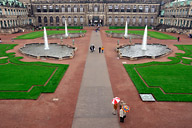 |
Fürstenzug Meissen Frieze
The Fürstenzug [Procession of Princes] is a huge mural on Meissen porcelain tiles, 101 metres long, depicting 35 of the most significant noblemen in the history of Saxony. It was created originally by Wilhelm Walter in 1876 using the technique of sgraffito, in which the top surface is scratched away to reveal a different colour underneath. Within 25 years the mural had been affected by damp from the Elbe, and the design was transferred to some 24,000 porcelain tiles produced by the nearby Meissen factory...
• Click for photos and more |
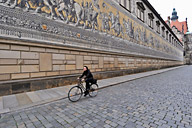 |
I'd arrived in Dresden at midday, and walked slowly into the centre down the wide Prager Straße. Everything is being modernised; new build, flashy clothes shops and phone shops. Smooth and clean. Huge rebuilding of the main roads in the centre, so big diversions for pedestrians.
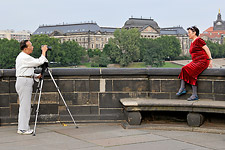 After visiting my main highlights, and with a hint of brightness in the sky, I walked past the Semperoper for a full-on daytime shot, then over the river to the guilded statue of Augustus the Strong – it really is a very bright and shiny thing, especially in the generally dull conditions but with some sun trying to break through. A walk back over the bridge, pausing only for a distant shot of the Frauenkirche, and a photo of a middle-aged Japanese couple doing a particularly extravagant version of the "take a picture of me with the church in the background" routine – he with a large tripod, she in maroon velvet dress perching on the wall over the river. Two or three of us stopped to watch, and I think the couple were amused and a little flattered at the interest they caused. After visiting my main highlights, and with a hint of brightness in the sky, I walked past the Semperoper for a full-on daytime shot, then over the river to the guilded statue of Augustus the Strong – it really is a very bright and shiny thing, especially in the generally dull conditions but with some sun trying to break through. A walk back over the bridge, pausing only for a distant shot of the Frauenkirche, and a photo of a middle-aged Japanese couple doing a particularly extravagant version of the "take a picture of me with the church in the background" routine – he with a large tripod, she in maroon velvet dress perching on the wall over the river. Two or three of us stopped to watch, and I think the couple were amused and a little flattered at the interest they caused.
A highlight for me was the restaurant brennNessel. It looks and feels somewhat like an English country pub, with lots of wood and beams, warm and welcoming, serving interesting and healthy food – mostly veggie – but tucked away in a slightly dodgy looking street (I'm sure it's not really, but you think you must be in the wrong place as you follow the map in the dark).
Thoughts on Dresden as I moved on to Leipzig: pleasant, spacious, airy. Massive regeneration and modernisation going on (who's paying for it?); unfortunately this makes it more difficult for photos. It will be great in one or two years time, assuming the building work doesn't just go on for ever. My apartment in a great location and comfortable, though almost too big! Well pleased with the Semperoper visit and night photos. Disappointed with the attitude – as I perceived it – at the Frauenkirche, and overall I didn't get as excited or moved by Dresden as I thought I would. Everything would be better with some sun. |
|
|